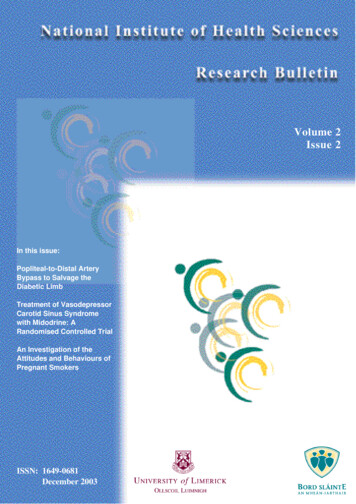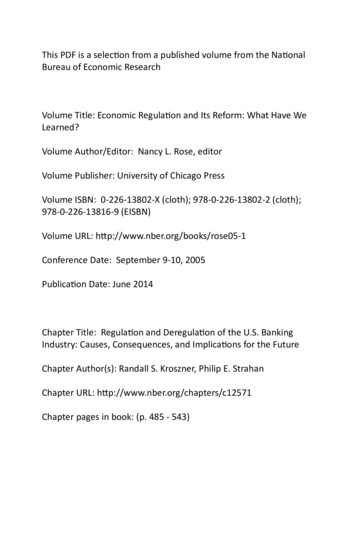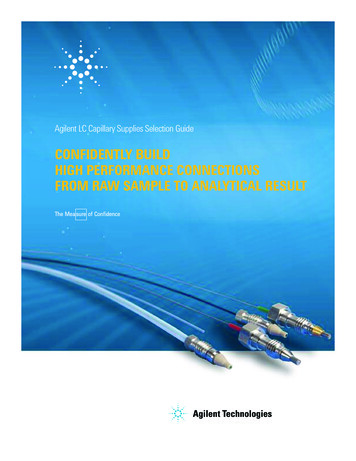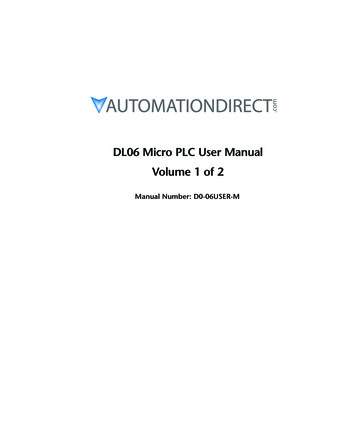
Transcription
Volume 2Issue 2In this issue:Popliteal-to-Distal ArteryBypass to Salvage theDiabetic LimbTreatment of VasodepressorCarotid Sinus Syndromewith Midodrine: ARandomised Controlled TrialAn Investigation of theAttitudes and Behaviours ofPregnant SmokersISSN: 1649-0681December 2003
R e s e a rc hBulletinVolume 2Issue 2
ISSN: 1649-06812003National Institute of Health Sciences, St. Camillus’Hospital, Shelbourne Road, Limerick, Ireland.All rights reserved. No part of this publication may be reproduced or transmitted in any form or by anymeans, electronic or mechanical, including photocopying, recording or any information storage andretrieval system, without permission from the contributors.C NIHS 2003Published by Designers Ink, LimerickIf you wish to contribute to future editions of the National Institute of Health Sciences Research Bulletin,please contact:National Institute of Health SciencesSt. Camillus’HospitalShelbourne iewww.nihs.ie
ContentspageForewordviEditorialviiMedicalA Prospective Double Blind Randomised Placebo-Controlled Comparison of Two PremedicationRegimens in Older People Undergoing Fibreoptic Bronchoscopy1Watts, M., Moore, A., Geraghty, R., Saunders, J., Swift, C.G.A Comparison of the Effect of Two Premedication Regimens on Cough Indices and Dose of TopicalLignocaine Required in Older People Undergoing Fibre Optic Bronchoscopy3Watts, M., Moore, A., Geraghty, R., Saunders, J., Swift, C.G.Carotid Intima-Media Thickness in Stroke Subtypes5Walsh T., O’Riordan R., Clinch D., Watts M., Lyons D.The Use of Fingernail in the Assessment of Bone Health: A Pilot Study6Pillay, I., Lyons, D., Chowdhury, S., German, M.J., Lawson, N.S., Pollock, H.M., Saunders, J., Moran, P., Towler, M.R.Referral Patterns to DEXA Scanning Service - Five-Year Follow Up Data7Pillay, I., O'Riordan, J., Costelloe, A., Sheehy, T., Lyons, D.Treatment of Vasodepressor Carotid Sinus Syndrome with Midodrine: A Randomised ControlledTrial8Moore, A., Watts, M., Hartnett, A., Sheehy, T., Stack, L., Costelloe, A., Clinch, D., Lyons, D.SurgicalPopliteal-to-Distal Artery Bypass to Salvage the Diabetic Limb9Brannigan A.E., Tubassum, M., Grace, P.A., Burke, P.E.Retrospective Audit of the Timing of Laparoscopic Cholecystectomy in Acute Cholecystitis10Cheema, S., Brannigan, A.E., Johnson, S., Delaney, P.V., Grace, P.A.Health-Related Quality of Life during Four Layer Compression Bandaging for Venous UlcerDisease: A Randomised Controlled Trial11Clarke Moloney, M., O’Brien, J.F., Grace, P.A., Burke, P.E.12Extended Uses of the Holmium: YAG Laser in UrologyO’Sullivan O., Clyne O., Flood H., Drumm J.V-Stat – The Perfect Vaginal Pack?14O’Sullivan O., Bannon C., Clyne, O., Flood H.The Snodgrass Repair: Is Stenting Really Necessary?16O’Sullivan, O., Bannon, C.A., Clyne, O., Flood, H.A Review of Hospital Re-admission with Post-Tonsillectomy Haemorrhage17Ullah, I., Keogh, P.F., Manning, K.P., Fenton, J.E.A Study of Non-Attendance Rate at the ENT/HNS Outpatient Clinics at the Mid-Western RegionalHospitalShaikh, M.A., Keogh, P.F., Manning, K.P., Fenton, J.E.iii18
pageEpidemiology of Mandibular Fractures: A Five-Year Review19Barry, C., Kearns, G.Isolated MandibularAngle Fractures, (MAF): A Five-Year Retrospective Study21Barry C., Kearns, G.Carotid Endarterectomy – A Regional Audit22Adelola, O.A., Weinstein, C.L., Naqvi, S.A., Burke, P., Grace, P.A.Nursing and MidwiferyOlder Peoples’Experience of Rehabilitation and the Transition to Home Following a Stroke24Conway, G.Consumer Satisfactory Survey of District Midwifery Service at the Regional Maternity Hospital26Clune, E.Mental Health ServicesAudit of Patients Referred from the Accident and Emergency Department of the Mid-WesternRegional Hospital Following Deliberate Self-Harm27O’Keeffe, B., Mulqueen, J.Clinical ServicesPatients Views on Open Visiting Hours in the Mid-Western Regional Hospital, Limerick28Donnelly, T., Pillay, I., Curtin, M., Rooney, O., O’Connor, B., Lyons, D., Watts, M., Clinch, D.Symmetry of the Functional Reach Test29McKenna, O., Blake, C.Mid-Western Health Board Haemovigilance is Associated with Reduced Usage and ImprovedAppropriateness of Blood Transfusion31Cahill, M.R., Joyce, S., O’Brien, N., Casey, M.Health PromotionDeveloping and Implementing Healthy Eating Guidelines in a Primary School Setting – A PilotApproach33Griffin A.C.An Investigation of the Attitudes and Behaviours of Pregnant Smokers34Gibbons, M., Mannix-McNamara, P.Health Services ManagementThe Nature of Internal Mediator and Moderator Influences in A Healthcare System in Transition36deBúrca, S.An Analysis of Casemix Structure in Ireland - Does it Treat Participating Hospitals Fairly?Brosnan, J.iv37
pageResearch in Progress SurgicalSedation in Paediatric Otoacoustic Emission Screening39Ahmed, I., Ramphul, N., Manning, K.P., Keogh, P.F., Fenton, J.E.Research in Progress Mental HealthAnalysis of Referral Letters to an Old Age Psychiatry DepartmentCampbell, F., Parsons, B., Loane, R.v40
ForewordThis issue coincides with news of significant change in the delivery system. The future triad of theHealth Services Executive, the restructured Department of Health & Children and the HealthInformation and Quality Authority will no doubt impact on the way we perform. We have a particularinterest in the role of HIQA as an enabler, influencer, regulator and promoter of evidence basedpractice based on high quality research data and information. Current initiatives in Research andDevelopment will bear fruit in due course. The academic-practitioner links are vital in this regard andwill be sustained by enhancing the relationship through common endeavour.I gratefully acknowledge and appreciate the extra effort of practitioners who demonstrate reflexivityand reflection in action. These contributions are indicative of the calibre of our staff and add to ourstore of knowledge and best practice.I am indebted to our editorial team Professor Pierce Grace, Mr John Fenton, Mr Pat Brosnan and MrAidan Hickey for their valued work in ensuring the success of this publication.Stiofán de Búrca Ph.D.Príomh Oifigeach Feidhmeacháinvi
EditorialThis issue of the NIHS Research Bulletin once again brings to our attention the wealth of researchactivity, from across a broad spectrum of healthcare arenas. Such energy and enthusiasm for newknowledge underpins the buoyant research culture of this region. The efforts of all contributors aregratefully acknowledged.Previous editorials have commented on the responsibility of healthcare professionals to becomecontributors to the knowledge base, primarily through enquiry-led learning and research activities.The desired target outcomes of such activities would ultimately lead towards improved patient careand advanced policy formulation.Policy and patient care are continually evolving and healthcare professionals over the years havebeen generally well disposed to the management of new knowledge by discarding ineffectiveinterventions and adopting effective ones. However, it is important to maintain vigilance andadherence to best practices, especially in light of the current economic circumstances, and steer clearof certain characteristics, which may appear at certain instances, the easier option but couldinadvertently lead to a significant decline in the calibre of healthcare service provision. Suchcharacteristics might include: Adoption of interventions of unproven efficacy or even proven ineffectivenessFailure to adopt interventions that do more good than harm at a reasonable costContinuing to offer services, demonstrated to be ineffectiveAdoption of services without appropriate preparation for translation from research to practiceCoupled with the pressures of an evolving administrative system, an ageing population and risingconsumer expectations, it is imperative that the management of new knowledge be kept in balanceand maintained at the highest levels, at all times.Aidan J. HickeyDirectorNational Institute of Health Sciencesvii
MedicalA Prospective Double Blind Randomised Placebo-Controlled Comparison of TwoPremedication Regimens in Older People Undergoing Fibreoptic BronchoscopyWatts, M., Moore, A., Geraghty, R., Saunders, J., Swift, C.G.Clinical Age Assessment Unit, Mid-Western Regional Hospital, LimerickIntroductionWith demographic changes and current epidemiology in developed countries, the highest proportion of patients requiringflexible fibre-optic bronchoscopy is elderly. Sedation prior to bronchoscopy should be offered to both improve patientcomfort, and make the procedure easier for the bronchoscopist.The most commonly used sedatives are the benzodiazepines and opioids. Older patients exhibit increased sensitivity tosome centrally acting drugs, which may alter the risk-benefit ratio of premedication regimens. A perceived increase inrisk may be used to justify restricting access to this important investigation on the grounds of age.There have, however, been no previously published prospective placebo-controlled studies specifically in older patientsto determine the merits of new or established regimens.We decided to compare an established premedication of intravenous alfentanyl (normal treatment) with a new regimenof oral temazepam plus nebulised lignocaine (new treatment).MethodologyConsecutive patients 75 years and older referred to the bronchoscopy list of the primary investigator (MW) wereconsidered for entry into this randomised prospective double blind placebo controlled comparison. Twenty five eligiblepatients were randomly assigned to each group. (See Table 1).Table 1 - Trial Profile117 assessed67 ineligible50 randomised25Temazepam 10mg pO T-60 minNebulised Lignocaine T-30 minN Saline 1-2mls IV T025SACLAB pO T-60 minNebulised N Saline T-30 minAlfentanyl 250-500mcg IV T0The primary outcome measure was the lowest oxygen saturation recorded from the administration of IV drugs and for30 minutes post bronchoscopy.1
ResultsFindings at bronchoscopy were similar in each group. (See Table 2).Table 2 - Findings at BronchoscopyDiagnostic CategoriesNew Treatment (temazepamplus nebulised lignocaine)Normal Treatment (alfentanyl)Bronchogenic carcinoma (total)1110Squamous cell85Adenocarcinoma24Small cell11Infection 10Extrinsic compression33Normal89The lowest mean oxygen saturation in the new treatment group was 92.2% (95% CI 90.3-94.2), and in the normaltreatment group 91.1% (95% CI 89.2-93.1).Figure 1 - Lowest Oxygen Saturation (%)This was not statistically significant (P .370). There were no procedure-related adverse events in any patient.ConclusionThis is the largest prospective study to date on an older population undergoing bronchoscopy. Determined by oxygensaturation there is no difference in safety between premedication regimens comprising oral temazepam/nebulisedlignocaine or intravenous alfentanyl. The study is consistent with previous evidence that bronchoscopy is a safeprocedure in older patients and points to the need for, and feasibility of, further prospective studies in this age group.PresentedAt the Irish Geriatrics Society Meeting in Tallaght Hospital, Dublin, 26-27 September, 2003 by Dr. M. Watts.Also, at the British Geriatrics Society Meeting in Hammersmith, London, 15-17 October, 2003 by Dr. M. Watts.ReferencesAvailable on request.2
MedicalA Comparison of the Effect of Two Premedication Regimens on Cough Indices andDose of Topical Lignocaine Required in Older People Undergoing Fibre OpticBronchoscopyWatts, M., Moore, A., Geraghty, R., Saunders, J., Swift, C.G.Clinical Age Assessment Unit, Mid-Western Regional Hospital, LimerickIntroductionOlder patients commonly require fibreoptic bronchoscopy. Lignocaine, administered during the procedure, is the mostcommonly used topical anaesthetic, used primarily to reduce cough, an uncomfortable experience for patients andtechnically compromising for the bronchoscopist. A total dose less than 8.2 mg/kg is recommended by the BTS, withextra caution in the elderly. Intravenous alfentanyl is a common premedication. We studied the effect of twopremedication regimens on the total dose of topical lignocaine required and cough indices.MethodologyThe study was carried out in three centres. Ethics committee approval was obtained. Consecutive patients 75 years andolder referred for bronchoscopy were considered for entry into this randomised prospective double blind placebocontrolled comparison. All patients had a full history and physical examination as well as a review of the case notes.Patients were excluded if taking any benzodiazepine or opioid, as were patients with resting oxygen saturations of lessthan 90% on room air and an abbreviated Mental Test Score of less than 7/10.25 patients received 10mg po temazepam T- 60 min, 4ml 2% nebulised lignocaine T- 30 min and 1-2mls N saline IV atT0 (New Treatment). 25 patients received SAC LAB po T-60 min, nebulised N saline T-30 minutes and 250-500mcgalfentanyl IV at T0 (Control group). (See Figure 1). The total dose of lignocaine used was recorded. The bronchoscopywas recorded with an audiotape, and cough indices calculated.Figure 1 - Trial Profile117 patients assessed for eligibility67 ineligible59 did not meet protocol criteria8 unwilling to participate50 randomised25 assigned “New Treatment”Temazepam 10mg pO T-60 minNebulised Lignocaine (4mls 2%) T-30 minN Saline (0·9% NaCl) 1-2mls IV T0Lignocaine 2% / 4% as required25 assigned “Normal Treatment”SAC LAB pO T-60 minNebulised N Saline (4mls 0·9%) T-30 minAlfentanyl 250-500mcg IV T0Lignocaine 2% / 4% as required3
ResultsTable 1 - ResultsVariableNew TreatmentControlPTotal lignocaine (mg) (median)2944720.0005Cough index (median)410 0.0005ConclusionCompared to an established premedication with intravenous alfentanyl, temazepam and nebulised lignocaine prior tobronchoscopy reduces the total dose of topical lignocaine required in older patients undergoing bronchoscopy andreduces cough. As topical lignocaine is absorbed into the systemic circulation, this may be clinically important inpreventing adverse events.PresentedAt the Irish Geriatrics Society Meeting in Tallaght Hospital, Dublin, 26-27 September, 2003 by Dr. M. Watts.Also, at the British Geriatrics Society Meeting in Hammersmith, London, 15-17 October, 2003 by Dr. M. Watts.ReferencesAvailable on request.4
MedicalCarotid Intima-Media Thickness in Stroke SubtypesWalsh T., O’Riordan R., Clinch D., Watts M., Lyons D.Stroke Unit, St. Camillus Hospital, LimerickClinical Age Assessment Unit, Mid-Western Regional Hospital, LimerickUniversity of LimerickIntroductionCarotid Intima-Media Thickness (CIMT) is a powerful predictor of future vascular risk. It may reflect blood pressureload exposure over time. The aim of this study was to determine if an association exists between CIMT and individualstroke subtypes.MethodologyA cross-sectional study of 61 successive Stroke Unit patients was performed. Stroke subtypes were determined using theOxford Community Stroke Project Classification. Haemorrhagic and Unclear Strokes were excluded (n 12). CIMTwas measured using B-mode ultrasound (Siemens Sonoline-Omnia) by a single-blinded observer. Blood pressure wasmeasured using a Space-Lab Ambulatory Blood Pressure Monitor.ResultsThirty male and nineteen female patients were studied. The mean age was 75.14 years (range 56-91). The mean (SD)CIMT (mm) for each infarct subtype was partial anterior circulatory infarct 0.9028 (0.27293), total anterior circulatoryinfarct 0.9115 (0.18275), lacunar infarct 0.9954 (0.21808) and posterior circulatory infarct 0.8320 (0.17065).ANOVA revealed no differences in CIMT between the stroke subtypes (p 0.544). The differences in means of systolicblood pressure (SBP), diastolic blood pressure (DBP), pulse pressure (PP) and mean blood pressure (MBP) between thestroke subgroups were not significant. There was a trend, however, towards higher mean CIMT, SBP, PP and MBP inthe lacunar group.ConclusionWhile no significant differences were found, trends towards higher CIMT, SBP, PP, and MBP were observed in lacunargroup. This may point to a role for altered large vessel compliance in lacunar stroke pathogenesis. The current datashould be expanded to conclusively address this possibility.ReferencesAvailable on request.5
MedicalThe Use of Fingernail in the Assessment of Bone Health: A Pilot StudyPillay, I.,1 Lyons, D.,1 Chowdhury, S.,2 German, M.J.,3 Lawson, N.S.,4 Pollock, H.M.,4 Saunders, J.,5 Moran, P.,6 Towler, M.R.61Clinical Age Assessment Unit, Mid-Western Regional Hospital, Limerick, Ireland2Materials & Surface Science Institute, University of Limerick, Ireland3Department of Biological Sciences, University of Lancaster, UK4Department of Physics, University of Lancaster, UK5Manager, Statistical Consulting Unit, University of Limerick, Ireland6Mechanical & Aeronautical Engineering Department, University of Limerick, IrelandIntroductionThere is anecdotal evidence that increasing hardness of fingernails occurs in patients within months of starting treatmentfor osteoporosis. As the properties of both nail and bone may be linked in a comparable, measurable way, we examinedthe nails of two groups of patients, those with and those without osteoporosis.MethodologyBone mineral density was assessed using Dual Energy X-ray Absorptiometry (DEXA) scanning (Lunar Prodigy, GEMedical systems). Nail samples from nine osteoporotic and thirteen non-osteoporotic patients were collected on whichmodulus and hardness were measured by nanoindentation. Nanoindentation was performed using a laboratory-builtmachine previously described by Arteaga et al. Disulphide bond content of five nail samples from each group wasmeasured by Raman spectroscopy using a Dilor Labram 01 instrument.ResultsThe mean difference in mean modulus between the groups was 0.996 but this was not significant at the 5% level(p 0.147). The spectroscopy data also showed differences between the two sets of nails. The disulphide bond content ofthe nails sourced from osteoporotic patients was much lower than those from healthy patients. There was also asignificant shift in carbon sulphide bond detection. The numbers were too small to allow a statistical comparison.DiscussionWe hypothesise that whilst bone collagen and nail keratin are two distinct structural proteins, they share the need forprotein sulphation and disulphide bond formation, via cysteine, for their structural integrity.A disorder of either processmay lead to disordered collagen and keratin synthesis. This would be reflected in the structural abnormalities seen inclinical syndromes in which there is either protein deficiency or disorders of sulphur metabolism.ConclusionThis is the first study to compare hardness, modulus and disulphide bond content of nail with bone mineral density asmeasured by DEXA. The p value for nail modulus between groups is quite low and indicates that a significant differencemight be found if a further study is undertaken which is sufficiently powered. The spectroscopy results are encouragingand demand further study in a larger sample.We conclude that the relationship between nail and bone may exist in a measurable way. If this is true it will add a newdimension to the aetiology of osteoporosis. Moreover, nail may prove to be a valuable adjunct to diagnosis and in somepatients, a means of follow-up after commencement of therapy.6
MedicalReferral Patterns to DEXA Scanning Service - Five-Year Follow Up DataPillay, I.,1 O'Riordan, J.,1 Costelloe, A.,1 Sheehy, T.,1 Lyons, D. 1,2Clinical Age Assessment Unit, Mid Western Regional Hospital, LimerickUniversity of Limerick 21IntroductionDEXAis the gold standard technique for the diagnosis of osteoporosis. The technique is becoming more widely availableand is an important tool in the characterisation of age associated bone disease. DEXAunits are being run by an increasingnumber of Medicine for Elderly Departments.MethodologyWe present data from a longitudinal study performed over a five-year period (1998 – 2003). The DEXA database(Filemaker Pro 5.5) at the Clinical Age Assessment Unit was interrogated to specifically assess referral patterns for thisdiagnostic test. All scans were performed by one of two specialist nurses on either a Lunar DPX Pro or GE Lunar Prodigymachine. Referrals are taken from primary care or secondary care doctors.ResultsThe results of 6,579 successive, initial DEXA scans were analysed. Outpatient referrals accounted for 6,184 (94%) ofall referrals. Women accounted for 5,658 (91%). 1,513 (23%) and 2,523 (38%) scans produced diagnoses of osteoporosisand osteopaenia respectively. The point prevalence rate of osteoporosis amongst public patients was twice as high asprivate patients (33% V 15%). The age profile of scanned patients is tabulated here. (See Table 1).Table 1 - Age Profile of Scanned Patients0-25 years26-45 years46-65 years66-85 years86-100 years107 (1.7%)598 (9.5%)3,585 (57.1%)1,870 (30%)106 (1.7%)The highest referring specialties for DEXAwere Obstetrics and Gynaecology, Medicine for the Elderly and Nephrology.ConclusionMore than 60% of those scanned had significant reductions in bone mineral density. Far fewer men are referred forDEXAthan one would predict based on the known prevalence of the disease in men. There is some evidence that selfselection for DEXAscanning takes place and is influenced by socio-economic status. Considerable education is neededto raise the awareness of osteoporosis diagnosis amongst specialties that are high steroid users.PresentedAt the Irish Gerontology Society Meeting in Tallaght Hospital, Dublin, on 26th September, 2003 by Dr. I. Pillay.7
MedicalTreatment of Vasodepressor Carotid Sinus Syndrome with Midodrine:A Randomised Controlled TrialMoore, A.,1 Watts, M.,1 Harnett, A.,2 Sheehy, T.,1 Stack, L.,1 Costelloe, A.,1 Clinch, D.,1 Lyons, D. 1Clinical Age Assessment Unit, Mid-Western Regional Hospital, Limerick1Pharmacy, Mid-Western Regional Hospital, Limerick2IntroductionThe carotid sinus syndrome (CSS) is an increasingly recognized cause of syncope in older people (McIntosh, S. et al.,Age Ageing 1993; 22:53-58). Treatment of the vasodepressor form of CSS is not well established however.MethodologyWe performed a crossover prospective double-blind randomised controlled trial in which patients with a 50mmHgsystolic blood pressure (SBP) decrease after carotid sinus massage (CSM) were randomized to receive either midodrine10mg TDS or placebo for two-week treatment periods with a one-week washout between treatment phases. BP changesproduced by CSM were evaluated by digital artery photoplethysmography (Finometer, FMF Medical Instruments,Amsterdam). Patients had 24-hour ambulatory BPmonitoring at trial entry and during each treatment phase. Differencesbetween groups were assessed with Chi Square analysis (symptom) and t tests (SBP decrease).Results10 patients (4M, 6F mean age 75) were studied. 8 had symptoms during initial CSM. The initial mean SBPdecrease afterCSM was 54mmHg (s.d 22mmHg). Initial mean 24-hour ambulatory BP was 127/70mmHg (s.d. 7/5mmhg). 8 patientshad symptoms after CSM at the end of placebo phase, mean SBP decrease 49mmHg (s.d. 9mmHg), mean 24-hourambulatory BP 127/69 (s.d. 9/7mmHg). One patient was symptomatic after CSM during active treatment phase, meanSBPdecrease after CSM 37mmHg (12mmHg), mean 24-hour ambulatory BP133/75mmHg (7/6mmHg). The differencesbetween active and placebo phases in symptom reporting and mean SBP decrease were significant (p 0.01 and p 0.03respectively).ConclusionMidodrine reduced the rate of symptom reporting and mean SBP decreases after CSM but increased 24-hour meanambulatory BP.8
SurgicalPopliteal-to-Distal Artery Bypass to Salvage the Diabetic LimbBrannigan A.E.,2 Tubassum, M.,2 Grace, P.A.,2 Burke, P.E.1St. John’s Hospital, Limerick1Department of Vascular Surgery, Mid-Western Regional Hospital, Limerick2IntroductionVascular disease, infection and neuropathy act synergistically in diabetics to cause foot ulceration leading to asignificantly higher incidence of limb loss compared with the general population. Revascularisation using femoralinfragenicular and femoral-inframalleolar bypasses are often lengthy procedures in a very high risk patient population.Poor long-term survival and significant co-morbidity among diabetic patients means that the shortest, simplestrevascularisation procedure that restores limb perfusion is desirable.RationaleThe aim of this study was to evaluate limb salvage, primary graft patency and peri-operative morbidity rates in elderlydiabetic patients undergoing popliteal to distal artery bypass for critical limb ischaemia.MethodologyPatients undergoing popliteal-to-distal artery bypass for critical limb ischaemia from January 1994 to May 2001 wereidentified using the hospital inpatient enquiry system (HIPE) and from Staff operative logbooks. Patient demographic,operative and follow-up data were entered into a database.ResultsDuring the study period 21 consecutive bypasses were performed on 19 patients. The median age was 70 years (Range61 to 80 years), male to female ratio was 16:3. Procedures were performed for category 5 ischaemia. All patients werediabetic, of whom 74% were insulin dependent, and 84 % had a history of ischaemic heart disease. A reversed vein graftwas used in all patients. Proximal inflow was via the above knee popliteal artery (n -4), the below knee popliteal artery(n 16) and a previous fem-popliteal bypass graft in (n 1). Distal anastomosis was to the posterior tibial artery above theankle (n 6), the dorsalis pedis artery (n 5), the anterior tibial artery above the ankle (n 6) and the peroneal artery (n 4).Thirteen patients received Aspirin post-operatively and 6 recommenced pre-operative Warfarin. The peri-operativemortality rate was 4.6%. Primary graft patency rates among surviving patients were 96%, 92% and 88% at 1, 2 and 6years respectively.ConclusionPopliteal-distal artery bypass is a favourable revascularisation procedure in high risk diabetic patients with critical limbischaemia.9
SurgicalRetrospective Audit of the Timing of Laparoscopic Cholecystectomy inAcute CholecystitisCheema, S.,1 Brannigan, A.E.,1 Johnson, S.,2 Delaney,P.V.,1 Grace, P.A.1Department of Vascular Surgery, Mid-Western Regional Hospital, Limerick1The National Institute for Health Science and Management, University of Limerick2IntroductionLaparoscopic cholecystectomy is the treatment of choice for symptomatic gallstones but is associated with an increasedconversion rate in acute cholecystitis. The aim of this study was to review the operative management of symptomaticcholelithiasis over a 5-year period with particular reference to conversion rates and morbidity associated withlaparoscopic cholecystectomy for acute cholecystitis.MethodologyPatients undergoing cholecystectomy between January 1994 and December 1998 were included. Data regardingdemographic details, diagnosis, duration of symptoms, treatment, outcome, postoperative stay and complications wereretrospectively recorded.ResultsComplete data was available on 482 patients (84%). Laparoscopic cholecystectomy was attempted in 120 of 132 patients(91%) with acute cholecystitis and 329 of 350 patients (94%) with non-acute gallbladder disease. Conversion rates were27% (33/120) and 6.7% (22/329) for acute and non-acute gallbladder disease, respectively (P 0.001 X2 test). In relationto the time interval from onset of symptoms to surgery, conversion rates for acute cholecystitis were: 3 days, 5/17(29%); 4 to 42 days, 14/59 (23%) and 42 days, 14/44 (31%). There were three bile duct injuries, two in the delayed( 45 days) acute group and one in the non-acute group.ConclusionCholecystectomy for acute cholecystitis is associated with a high conversion which is independent of the timing ofsurgery. We conclude that early laparoscopic cholecystectomy is the treatment of choice for acute cholecystitis.10
SurgicalHealth-Related Quality of Life During Four Layer Compression Bandaging forVenous Ulcer Disease: A Randomised Controlled TrialClarke Moloney, M.,2 O’Brien, J.F.,2 Grace, P.A.2, Burke, P.E.1Department of Vascular Surgery, St. John’s Hospital, Limerick1Department of Vascular Surgery, Mid-Western Regional Hospital, Limerick2Introduction and RationaleLeg ulcers are a common and debilitating problem with a prevalence in Ireland of 0.12% overall, increasing to 1.03% inpatients over 70 years of age. Eighty one percent of leg ulcers are venous in origin, resulting from venous hypertension.The application of graduated compression bandaging is the most widely recognised treatment for venous leg ulcers. 5070% of ulcers heal at 12 weeks with this treatment.Venous leg ulceration is a chronic condition which can result in pain, limit mobility, alter body image and lower selfesteem, all of which negatively impact on patient’s quality of life. Therefore, when choosing treatment for a patientwith venous ulceration it is imperative that treatment not only accelerates healing but also improves quality of life.The aim of this study was to compare the effects of four-layer compression bandaging (4LB) for treating venous legulcers with other available treatments on health-related quality of life during treatment.MethodologyIn this pragmatic trial, 200 patients with a venous leg ulcer were randomised either to 4LB (intervention group; n 100)or to continue their usual system of care (control group; n 100). The follow-up period for each patient was 12 weeks.Analysis was by intention to treat; quality of life measurements were taken at randomisation and after six weeks oftreatment. The quality of life questionnaires used were the disease specific CIVIQ and the generic SF-36. The outcomemeasure examined was change in health-related quality of life status, as perceived by patients during treatment.ResultsThe CIVIQ showed the most disc
If you wish to contribute to future editions of the National Institute of Health Sciences Research Bulletin, please contact: National Institute of Health Sciences St. Camillus'Hospital Shelbourne Road Limerick t: 061-483975 f: 061-483974 e: info@nihs.ie w: www.nihs.ie











